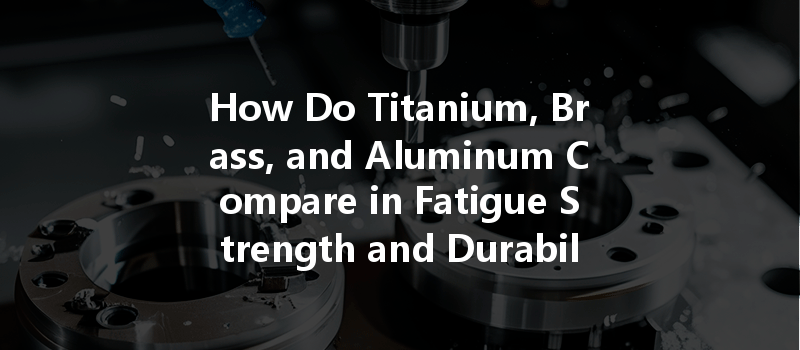*
In the intricate world of machining, every material tells a story. Each alloy, with its unique characteristics and capabilities, serves an essential role in manufacturing, influencing outcomes from performance to longevity. At YL Machining, we don’t just see metals; we see potential waiting to be unlocked through the precision of CNC processing. In this article, we’ll unlock the secrets behind fatigue strength and durability in three key players: titanium, brass, and aluminum. By the end, you will not only gain insight into their individual attributes but also understand how to effectively choose the right material for your specific applications.
—
The Foundation of CNC Processing
Before diving into the properties of titanium, brass, and aluminum, it’s important to understand the basics of CNC (Computer Numerical Control) processing. CNC machining transforms raw materials into precision-engineered parts, employing a series of programmed instructions that dictate the motions and operations of machine tools.
The strength of CNC processing lies in its ability to handle a variety of materials with precision. However, the choice of material plays a crucial role in determining the behaviour, efficiency, and durability of the final product. Here, fatigue strength and durability take center stage as we explore each material’s ability to withstand repeated stress without failure and endure harsh environments.
—
Titanium: The Aerospace Ally
Titanium, known for its impressive strength-to-weight ratio, corrosion resistance, and biocompatibility, is often the go-to choice in aerospace, medical devices, and military applications. It’s classified as a transition metal, and its unique properties make it highly sought after despite its higher cost compared to brass and aluminum.
Fatigue strength refers to the ability of a material to withstand cycles of loading and unloading without failure. For titanium, this attribute is particularly remarkable. Its high fatigue strength values—typically around 900-1,200 MPa—make it ideal for components exposed to high-stress environments, such as aircraft frames and jet engines.
The underlying mechanisms contributing to titanium’s fatigue strength include its microstructure and alloying elements. Titanium alloys, such as Ti-6Al-4V, exhibit superior fatigue resistance due to their alpha-beta phase structures, leading to better load distribution and crack propagation resistance.
When it comes to durability, titanium shines in aggressive environments, thanks to its exceptional corrosion resistance stemming from a passive oxide layer that forms on its surface. This makes it a formidable choice for marine applications, chemical processing, and medical implants, where longevity and reliability are paramount.
Nonetheless, it’s important to consider the cost implications. The price point for titanium is substantially higher than brass or aluminum, and this can affect your project budget significantly. While the performance benefits may outweigh costs in critical applications, this trade-off must be evaluated on a case-by-case basis.
—
Brass: The Versatile Contender
Brass, a copper-zinc alloy, is renowned for its workability, corrosion resistance, and aesthetic appeal. Commonly used in plumbing fixtures, electrical components, and musical instruments, its versatility is an important factor in many manufacturing processes.
Brass is less durable than titanium, with fatigue strength typically in the range of 300-550 MPa, depending on its alloy composition. While it exhibits adequate fatigue resistance for lower-stress applications, it is not ideal for high-performance environments where cyclic loading is prevalent.
For applications such as valve components and fixtures, where operational demands are moderate, brass proves effective. Its ability to absorb vibrations can be advantageous in electronic applications built upon its acoustic properties.

In terms of durability, brass demonstrates moderate corrosion resistance. It performs well in atmospheric and freshwater environments but may succumb to dezincification when exposed to seawater, a common concern in marine applications. This calls for a careful selection of brass grade and finish, particularly in scenarios where prolonged exposure to moisture is expected.
Another competitive edge of brass is its cost-effectiveness. Generally speaking, brass is cheaper than titanium and only slightly more expensive than aluminum. This makes it a favourable choice for many applications that require a combination of aesthetics and functionality without breaking the bank.
—
Aluminum: The Lightweight Hero
Aluminum, known for its lightweight properties and excellent corrosion resistance, is the most widely utilized non-ferrous metal in machining. Commonly found in the automotive and aerospace industries, its flexibility allows it to be molded into complex shapes without affecting the final product’s integrity.
Aluminum typically exhibits a fatigue strength in the range of 140-300 MPa, which is significantly lower than both titanium and brass. However, variants such as 7075 aluminum alloy can raise fatigue strength values nearing those of higher-performing metals.
Where aluminum excels is in its durability with respect to corrosion resistance. Its surface naturally forms alumina when exposed to air, providing a protective barrier against various environmental conditions. This property makes aluminum increasingly popular for outdoor applications, transportation, and packaging.
Aluminum’s affordability makes it a preferred choice across myriad applications. It is generally less expensive than titanium and comparable in price to brass, offering an appealing blend of performance and cost-effectiveness.
—
: Choosing the Right Material
In conclusion, the choice between titanium, brass, and aluminum ultimately boils down to your specific application requirements.
As YL Machining, we pride ourselves on helping you navigate these complexities, ensuring every component manufactured meets the highest standards of durability and performance. By understanding the strength differences between these materials, you can make informed choices that not only adhere to your project specifications but elevate your production processes to new heights.
Thank you for joining us on this journey through the world of materials in CNC processing. Keep exploring, questioning, and innovating—this is just the beginning of what you can achieve!
—
Remember, if you’re looking for expert guidance on CNC machining projects, YL Machining is here to help you select the right materials and processes tailored to your needs. Join us as we continue to explore the infinite possibilities that technology brings to the world of manufacturing.






